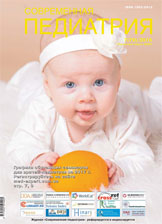Cиндром непереносимости гистамина у детей
DOI:
https://doi.org/10.15574/SP.2016.79.60Ключевые слова:
аллергические состояния у детей, гистамин, диаминоксидаза (ДАО), синдром непереносимости гистамина (СНГ), кожный прик-тест, заместительная терапия, псевдоаллергия, тест Гистамин-50Аннотация
В последние годы отмечается значительный рост аллергических состояний. В клинике преобладают IgE-независимые механизмы развития аллергических состояний, в основе которых лежит нарушение обмена гистамина в организме. Увеличение уровня внеклеточного гистамина на фоне уменьшения активности фермента диаминоксидазы (ДАО) приводит к появлению синдрома непереносимости гистамина (СНГ). Для этого состояния характерно большое разнообразие клинических проявлений. Наиболее информативным методом диагностики СНГ является кожный прик-тест с гистамином (Тест Гистамин-50), который позволяет подтвердить низкую активность ДАО в организме и необходимость проведения заместительной терапии.
Ключевые слова: аллергические состояния у детей, гистамин, диаминоксидаза (ДАО), синдром непереносимости гистамина (СНГ), кожный прик-тест, заместительная терапия, псевдоаллергия, тест Гистамин-50.
Библиографические ссылки
Gatskaya DA, Koritskaya IV. 2015.Dinamika rasprostranennosti allergicheskih zabolevaniy sredi detey i molodezhi Vinnitskoy oblasti (rezultatyi pervogo etapa epidemiologicheskogo issledovaniya). Astma ta alergIya. 1: 17—22.
Kamps Antonio Rossel. 2015. Klinicheskie aspektyi pitaniya i neperenosimosti gistamina u detey s simptomami hronicheskogo narusheniya pischevareniya. Moskva: 156.
Pukhlyk BM, Dytiatkivska YeM, Hohunska IV. 2012. Pytannia poshyrenosti ta ekonomichnoi efektyvnosti likuvannia alerhiinykh zakhvoriuvan orhaniv dykhannia v Ukraini. Klinichna imunolohiia Alerholohiia Infektolohiia. 2: 5—8.
Rukovodstvo po immunofarmakologii. Pod red MM Deyla, DzhK Formena. Moskva, Meditsina. 1998: 332.
Arock M, Valent P. 2010. Pathogenesis, classification and treatment of mastocytosis: state of the art in 2010 and future perspectives. Expert Rev Hematol. 3: 497—516. https://doi.org/10.1586/ehm.10.42; PMid:21083038
Asher ML, Humbert M. 2004. International Study of Asthma and Allergies in Childhood (ISAAC). Amer Thoracic Society. SCAN: 3.
Asher ML. 1998. ISAAC Steering Committee. Clin Exp Allergy. 28;Suppl 5; 52: 66.
Bieganski T. 1983. Biochemical, physiological and pathophysiological aspects of intestinal diamine oxidase. Acta Physiolo Pol. 34: 139—54. PMid:6416024
Black AK. 2001. Unusual urticarias. J Dermatol. 28(11): 632—4. https://doi.org/10.1111/j.1346-8138.2001.tb00050.x; PMid:11770721
Verma A, Deb DK, Sassano A et al. 2002. Cutting edge: activation of the p38 mitogen activated protein kinase signaling pathway mediates cytokine-induced hemopoietic suppression in aplastic anemia. J Immunol. 168: 5984—8. https://doi.org/10.4049/jimmunol.168.12.5984; PMid:12055203
Dale HD, Laidlaw PD. 1910. The physiological action of β-iminazolyl-ethylamine. J Physiol (London). 41: 318—344. https://doi.org/10.1113/jphysiol.1910.sp001406; PMid:16993030 PMCid:PMC1512903
Kofler H, Aberrer W, Deibi M et al. 2009. Diamine oxidase (DAO) serum activity: not a useful marker for diagnosis of histamine intolerance. Allergologie. 32: 105—9. https://doi.org/10.5414/ALP32105
Colome Rivero G, Tormo Carnicer R, Rosell Camps A et al. 2014. Diaminooxidase low levels and paediatric gastrointestinal pathology. 47Th Annual Meeting of the European Society for Paediatric Gastroenterology, Hepatology and Nutrition. 9—12 June 2014. Jerusalem, Israel.
Ellenbroek BA, Ghiabi B. 2014. The other side of the histamine H3 receptor. Trends Neurosci. 37(4): 191—9. https://doi.org/10.1016/j.tins.2014.02.007; PMid:24636456
Komericki P, Klein G, Reider N et al. 2011. Histamine intolerance:lack of reproducibility of single symptoms by oral provocation with histamine: a randomized, double-blind, placebo-controlled cross-over study. Wien Klin Wochenschr. 123(1—2): 15—20. https://doi.org/10.1007/s00508-010-1506-y; PMid:21165702
Cataldi M, Borriello F, Granata F et al. 2014. Histamine receptors and antihistamines: from Discovery to clinical applications. Chem Imunol Allergy. 100: 214—26. https://doi.org/10.1159/000358740; PMid:24925401
Humbert M. 2004. Editorial 100* International Conference of the Amer. Thoracic Society. SCAN: 3.
Jadidi-Niaragh F, Mirshafiey A. 2010. Histamine and histamine receptors in pathogenesis and treatment of multiple sclerosis. Neuropharmacology. 59: 180—9. https://doi.org/10.1016/j.neuropharm.2010.05.005; PMid:20493888
Maintz L, Novac N. 2007. Histamine and histamine intolerance. Am J Clin Nutr. 85: 1185—96. PMid:17490952
Maintz L, Bieber T, Novak N. 2006. Histamine intolerance in clinical practice. Dtsch Arttebl. 103(51—52): 3477—83.
Vlieg-Boerstra BJ, van der HS, Oude Elberink JN et al. 2005. Mastocytosis and adverse reactionsto biogenic amines and histaminereleasing foods: what is the evidence? Neth J Med. 63: 244—9. PMid:16093574
Ring J. 2004. Angewandte Allergologie (Implemented allergology). Munich, Germany: Urban & Vogel.
Schwelberger HG. 2009. Histamine intolerance: overestimated or underestimated? Inflamm Res. 58(S1): 51—2. https://doi.org/10.1007/s00011-009-2004-4; PMid:19271146
Music E, Korosec P, Silar M et al. 2013. Serum diamine oxidasa activity as a diagnostic test for histamine intolerance. Wien Kin Wochenschr. 125(9—10): 239—43. https://doi.org/10.1007/s00508-013-0354-y; PMid:23579881
Steinbrecher I, Jarisch R. 2005. Histamin und Kopfschmerz. Allergologie. 28: 84—91. https://doi.org/10.5414/ALP28085
Tabarean IV. 2015, Jun 21. Histamine receptor signaling in energy homeostasis. Neuropharmacology. PMid:26107117
Cingi C, Songu M, Ural A, Annesi-Maesano I. 2011. The score for allergic rhinitis study in Turkey. Am J Rhinol Allergy. 25: 333—337. https://doi.org/10.2500/ajra.2011.25.3665; PMid:22186248
Thurmond RL. 2015. The histamine H4 receptors: from orphan to the clinic. Front Pharmacol. 31(6): 65. https://doi.org/10.3389/fphar.2015.00065
Izquierdo J, Mon D, Lorente M, Soler Singla L. 2013. Un estudio randomizado doble ciego para el tratamiento con diaminooxidase (DAO) en pacientes con migrana y deficit de actividad DAO. XXI World Congress of neurology 2013. Viena. Austria.
Zampeli E, Tiligada E. 2009. The role of histamine H4 receptor in immune and inflamatory disorders. British Journal of Pharmacology. 157: 24—33. https://doi.org/10.1111/j.1476-5381.2009.00151.x; PMid:19309354 PMCid:PMC2697784

